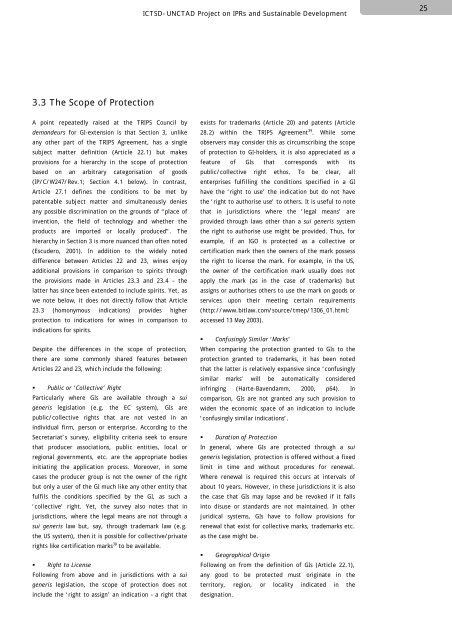Geographical Indications
Geographical Indications
Geographical Indications
You also want an ePaper? Increase the reach of your titles
YUMPU automatically turns print PDFs into web optimized ePapers that Google loves.
ICTSD-UNCTAD Project on IPRs and Sustainable Development253.3 The Scope of ProtectionA point repeatedly raised at the TRIPS Council bydemandeurs for GI-extension is that Section 3, unlikeany other part of the TRIPS Agreement, has a singlesubject matter definition (Article 22.1) but makesprovisions for a hierarchy in the scope of protectionbased on an arbitrary categorisation of goods(IP/C/W247/Rev.1; Section 4.1 below). In contrast,Article 27.1 defines the conditions to be met bypatentable subject matter and simultaneously deniesany possible discrimination on the grounds of “place ofinvention, the field of technology and whether theproducts are imported or locally produced”. Thehierarchy in Section 3 is more nuanced than often noted(Escudero, 2001). In addition to the widely noteddifference between Articles 22 and 23, wines enjoyadditional provisions in comparison to spirits throughthe provisions made in Articles 23.3 and 23.4 – thelatter has since been extended to include spirits. Yet, aswe note below, it does not directly follow that Article23.3 (homonymous indications) provides higherprotection to indications for wines in comparison toindications for spirits.Despite the differences in the scope of protection,there are some commonly shared features betweenArticles 22 and 23, which include the following:! Public or ‘Collective’ RightParticularly where GIs are available through a suigeneris legislation (e.g. the EC system), GIs arepublic/collective rights that are not vested in anindividual firm, person or enterprise. According to theSecretariat’s survey, eligibility criteria seek to ensurethat producer associations, public entities, local orregional governments, etc. are the appropriate bodiesinitiating the application process. Moreover, in somecases the producer group is not the owner of the rightbut only a user of the GI much like any other entity thatfulfils the conditions specified by the GI, as such a‘collective’ right. Yet, the survey also notes that injurisdictions, where the legal means are not through asui generis law but, say, through trademark law (e.g.the US system), then it is possible for collective/privaterights like certification marks 38 to be available.! Right to LicenseFollowing from above and in jurisdictions with a suigeneris legislation, the scope of protection does notinclude the ‘right to assign’ an indication – a right thatexists for trademarks (Article 20) and patents (Article28.2) within the TRIPS Agreement 39 . While someobservers may consider this as circumscribing the scopeof protection to GI-holders, it is also appreciated as afeature of GIs that corresponds with itspublic/collective right ethos. To be clear, allenterprises fulfilling the conditions specified in a GIhave the ‘right to use’ the indication but do not havethe ‘right to authorise use’ to others. It is useful to notethat in jurisdictions where the ‘legal means’ areprovided through laws other than a sui generis systemthe right to authorise use might be provided. Thus, forexample, if an IGO is protected as a collective orcertification mark then the owners of the mark possessthe right to license the mark. For example, in the US,the owner of the certification mark usually does notapply the mark (as in the case of trademarks) butassigns or authorises others to use the mark on goods orservices upon their meeting certain requirements(http://www.bitlaw.com/source/tmep/1306_01.html;accessed 13 May 2003).! Confusingly Similar ‘Marks’When comparing the protection granted to GIs to theprotection granted to trademarks, it has been notedthat the latter is relatively expansive since ‘confusinglysimilar marks’ will be automatically consideredinfringing (Harte-Bavendamm, 2000, p64). Incomparison, GIs are not granted any such provision towiden the economic space of an indication to include‘confusingly similar indications’.! Duration of ProtectionIn general, where GIs are protected through a suigeneris legislation, protection is offered without a fixedlimit in time and without procedures for renewal.Where renewal is required this occurs at intervals ofabout 10 years. However, in these jurisdictions it is alsothe case that GIs may lapse and be revoked if it fallsinto disuse or standards are not maintained. In otherjuridical systems, GIs have to follow provisions forrenewal that exist for collective marks, trademarks etc.as the case might be.! <strong>Geographical</strong> OriginFollowing on from the definition of GIs (Article 22.1),any good to be protected must originate in theterritory, region, or locality indicated in thedesignation.









